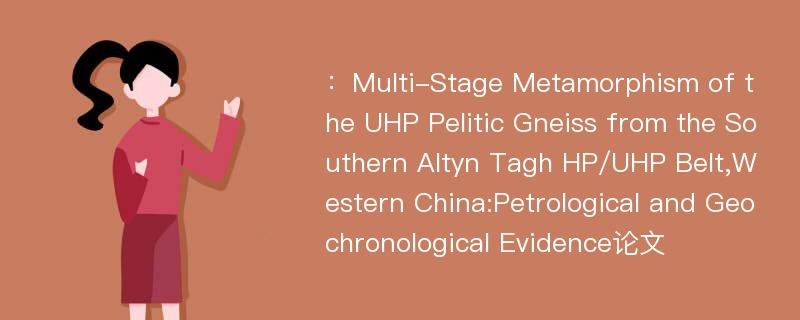
本文主要研究内容
作者(2019)在《Multi-Stage Metamorphism of the UHP Pelitic Gneiss from the Southern Altyn Tagh HP/UHP Belt,Western China:Petrological and Geochronological Evidence》一文中研究指出:The kyanite-bearing garnet pelitic gneiss from the Jianggalesayi area in southern Altyn Tagh high pressure/ultra-high pressure belt was proved to have been experienced UHP metamorphism(>12 GPa)by the discovery of kyanite and spinel exsolution microstructure in quartz(precursor stishovite).In this study,three stages of retrograded metamorphism(M2–M4)after the UHP metamorphism(M1)were identified for the UHP pelitic gneiss.The HP granulite-facies stage(M2)was characterized by the mineral assemblage of garnet+kyanite+K-feldspar+rutile+quartz±ilmenite,recording the P-T condition of>1.12 GPa and~850–930oC.The granulite-facies stage(M3)was represented by the mineral assemblage of garnet rim+K-feldspar+sillimanite(Sill1)+biotite(Bt1)+plagioclase(Pl1)+ilmenite+quartz,and confined under P-T conditions of 0.5–0.8 GPa and~770–795oC.The late cooling stage M4 was accompanied by the appearance of fine-grained Pl2,Sill2 and Bt2in the matrix,and the P-T conditions were0.4–0.6 GPa and<675oC.A clockwised P-T path was obtained for the pelitic gneiss in the P-T pseudosection,which showed a deep subduction/collision processes with subsequent exhumation and cooling.Combined with the corresponding multistage metamorphic assemblages,the age dating results implied that the zircons from the gneiss have integrated the recording peak metamorphic(M1,484±3 Ma)and retrograded metamorphic ages(M2 to M3,450±2 Ma).There was about 32 Ma interval during the first exhumation from the upper mantle depth(>350 km)to the lower crust depth(~40–20 km),resulting in an average exhumation rate of 9.11–9.70 mm/yr.In the southern Altyn Tagh region,the HP and UHP rocks from different areas had identical peak metamorphic ages.Therefore,contemporary UHP and HP rocks with different metamorphic evolutions were recognized coexisting in the same orogenic belt,which can be interpreted by the model of subduction channel.The continental crustal were subducted to different depths along the direction of the subduction channels at~500 Ma,suffered different grade metamorphism,and then returned to the surface along the subduction channel.
Abstract
The kyanite-bearing garnet pelitic gneiss from the Jianggalesayi area in southern Altyn Tagh high pressure/ultra-high pressure belt was proved to have been experienced UHP metamorphism(>12 GPa)by the discovery of kyanite and spinel exsolution microstructure in quartz(precursor stishovite).In this study,three stages of retrograded metamorphism(M2–M4)after the UHP metamorphism(M1)were identified for the UHP pelitic gneiss.The HP granulite-facies stage(M2)was characterized by the mineral assemblage of garnet+kyanite+K-feldspar+rutile+quartz±ilmenite,recording the P-T condition of>1.12 GPa and~850–930oC.The granulite-facies stage(M3)was represented by the mineral assemblage of garnet rim+K-feldspar+sillimanite(Sill1)+biotite(Bt1)+plagioclase(Pl1)+ilmenite+quartz,and confined under P-T conditions of 0.5–0.8 GPa and~770–795oC.The late cooling stage M4 was accompanied by the appearance of fine-grained Pl2,Sill2 and Bt2in the matrix,and the P-T conditions were0.4–0.6 GPa and<675oC.A clockwised P-T path was obtained for the pelitic gneiss in the P-T pseudosection,which showed a deep subduction/collision processes with subsequent exhumation and cooling.Combined with the corresponding multistage metamorphic assemblages,the age dating results implied that the zircons from the gneiss have integrated the recording peak metamorphic(M1,484±3 Ma)and retrograded metamorphic ages(M2 to M3,450±2 Ma).There was about 32 Ma interval during the first exhumation from the upper mantle depth(>350 km)to the lower crust depth(~40–20 km),resulting in an average exhumation rate of 9.11–9.70 mm/yr.In the southern Altyn Tagh region,the HP and UHP rocks from different areas had identical peak metamorphic ages.Therefore,contemporary UHP and HP rocks with different metamorphic evolutions were recognized coexisting in the same orogenic belt,which can be interpreted by the model of subduction channel.The continental crustal were subducted to different depths along the direction of the subduction channels at~500 Ma,suffered different grade metamorphism,and then returned to the surface along the subduction channel.
论文参考文献
论文详细介绍
论文作者分别是来自Journal of Earth Science的,发表于刊物Journal of Earth Science2019年03期论文,是一篇关于,Journal of Earth Science2019年03期论文的文章。本文可供学术参考使用,各位学者可以免费参考阅读下载,文章观点不代表本站观点,资料来自Journal of Earth Science2019年03期论文网站,若本站收录的文献无意侵犯了您的著作版权,请联系我们删除。
